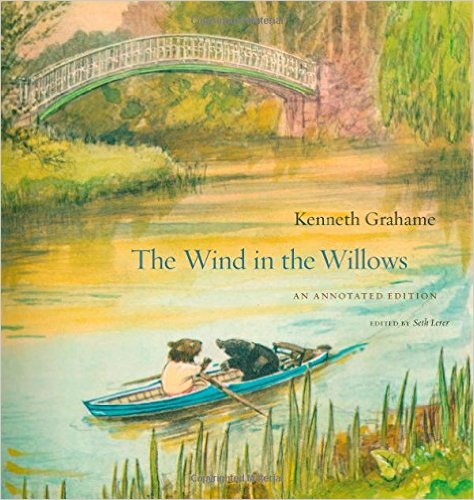Annotated Wind In The Willows
Reviewed by David Bratman
The Wind in the Footnotes: Reviews of two new annotated editions of Kenneth Grahame’s The Wind in the Willows
[This review originally appeared in Mythprint 47:4 (#333) in April 2010.]
It never rains but it pours: I am sitting here with library copies of two different annotated editions of The Wind in the Willows, one boldly titled The Annotated Wind in the Willows, edited by Annie Gauger (Norton, 2009), and the other more humbly titled The Wind in the Willows: An Annotated Edition, edited by Seth Lerer (Belknap Press, 2009). They’re very different.
Anyone who ventures to annotate a classic should sit down and take a hard thought first: exactly what about this work needs annotation? And: do I have enough to say to justify inflicting a fat volume with wide margins on the public? The first classic modern annotation was Martin Gardner on Alice, a body of work just full of obscure mathematical jokes and literary allusions that would greatly benefit the reader by being explained. Now we’re down to the simple, straightforward pastorales of Kenneth Grahame.
Lerer is the annotator who doesn’t have enough to say. His book is full of enough dismayingly-long blank spaces through interesting parts of the narrative that you wonder why he bothered. At least he’s sober and scholarly about what he does say. Most of his annotations are dictionary references elaborating on word usage, with occasional literary allusions, mostly to authors pre-dating Grahame. There’s a rather ponderous notation on his p. 238 regarding the one actual language-prescriptivist argument among the characters in the book. (Don’t tell me you don’t remember this.)
Gauger does not worry much about meanings of words, though she does annotate this one, rather more succinctly, on her p. 280, but if you compare the two annotations you’ll find the worrying little fact that, while Lerer quotes a book cited in the OED, clearly identifying the source book, Gauger makes the point in almost exactly the same words without revealing that this came from anywhere. In some circles, this would be called plagiarism. Uh-oh.
Nor is that Gauger’s only obvious mistake. Annotating the word “bus” in “Wayfarers All” on p. 209, she quotes A.D. Godley’s frantically humorous Latin invocation against the motor buses on the streets of Oxford, adding the common error that “J.R.R. Tolkien illustrated [it] in 1927,” which he did not; he owned a copy of a broadside of the poem printed that year, illustrated by Iain Macnab (J.R.R. Tolkien: Life and Legend, catalog of a Bodleian exhibition in 1992, p. 85; the reproduction of the broadside on p. 86 has possibly given rise to the misattribution).
If Gauger isn’t much interested in the definitions of words, she does make comments on the development of the text, which is good (Lerer ignores this), and comparisons to other authors including later ones up to J.K. Rowling (another clang on p. 4-5 where she claims that Grahame’s depiction of rabbits as stupid was shared by A.A. Milne; actually, Milne’s Rabbit is his only animal character with any brains at all, and the quote from House at Pooh Corner she gives in support of her argument only proves that Rabbit is fussy and pompous and that Eeyore is condescending and insulting), and lots and lots of boldly speculative source notes for everything from scenery to character motivation. They do push the text off the page at times, requiring flipping back and forth to find the annotations. This is not always superior to Lerer’s blank space. Neither annotator has any comment to make on why Ratty says that he is both afraid and not afraid of the piper at the gates of dawn. I’d have thought this a point well worth literary discussion. Gauger does provide a note at this spot, which one turns to eagerly only to discover that it’s to inform you of … a binding error in the Bodleian’s copy of the manuscript. How anti-climactic and unnecessary can you get?
Lerer has very few illustrations except for a color section; Gauger has lots of illustrations and photos. She shows a particular partiality for the truly ghastly work of one Wyndham Payne, who illustrated a 1920s edition of the book, and includes relatively few of Ernest Shepard’s. And speaking of illustrations, here’s The Illustrators of The Wind in the Willows, 1908–2008 by Carolyn Hares-Stryker (McFarland, 2009), covering a cast beginning with a trickle and spreading into a flood in recent years. The illustrations book is a work of compilation but not of scholarship, and I can’t highly recommend either of the annotated editions. An interleaved edition of both would be worse than either; the ideal annotated Wind, if any, would be about halfway between them.



